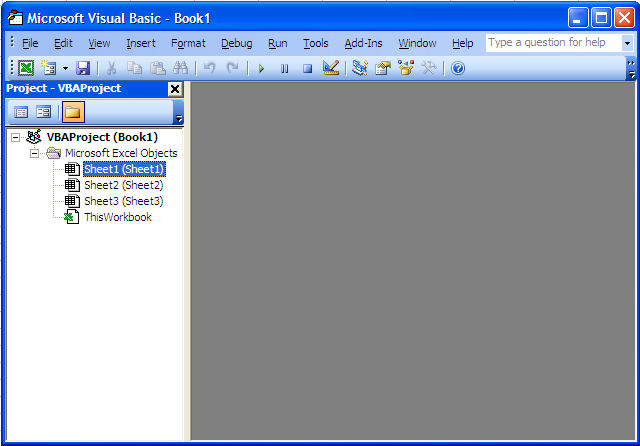The Visual Basic Editor is a program within Excel that allows you to communicate with Excel. We will open it and start by setting it up so that working within it becomes easy and efficient.
- Open Excel and open a new workbook (Book1).
- On your keyboard press the "ALT" key (left of the space bar) and hold, strike the "F11"key (the F11 key is at the top of your keyboard).You now see the Visual Basic Editor. Again press "ALT/F11" and you are back into Excel. Use the "ALT/F11" key to go from Excel to the VBA and back.
When you first open the VBE you will see is a window somewhat like the image below

If there are any open windows within the VBE like in the image below click on the Xs to close them and see a gray rectangle filling up the bottom part of the screen like in the image above.

The Three Windows in the Visual Basic Editor
To be efficient when working with the VBE there should always be 3 windows showing like in the image below;
- Project Window
- Code Window
- Properties Window

In the exercise below we will setup the 3 windows of the VBE.
Exercise 1 (Create your first macro and use it)
Remember that you will perform this task only once as each time you will open the VBE it will remain setup.
Step 1: Close all the windows that are open in the VBE to end up with this:

Step 2: Go to the menu bar "View" and click "Project Explorer". The result will be somewhat like the image below:

If the project window already appears as a column on the left side of the screen there is nothing else that you have to do for now. If the project window appears in the middle of the gray area like above, right-click in the white space in the middle of the project window and check "Dockable". Then click on the top blue bar of the Project window, hold and drag it left until the cursor (white arrow) touches the middle of the left side of the screen. When you let go of the mouse button the end result should be like shown in the image below. Congratulations you have setup the first major window of the VBE.

Step 3: Move your cursor on the line separating the project window and the gray rectangle. When it turns to two small parallel lines and arrows click, hold and move the lines sideways. Resize the two windows as you want them.
Step 4: Go back to the menu bar "View" and click "Properties Window". The Properties window will appear somewhat like in the image below.

If the Properties window is already located below the Project window there is nothing left to do. If it shows like in the image above, right-click in the white space in the middle of the Properties window and check "Dockable". Then click on the top blue bar of the Properties window and drag it left and down until the cursor (white arrow) touches the center of the bottom of the Project window. When you let go of the mouse button the end result should be as the image below. Congratulations you have setup the second major window of the VBE.

Step 5: Move your cursor on the line separating the project window and the properties window. When it turns to two small parallel lines and arrows click, hold and move the lines vertically. Resize the two windows as you want them.
Step 6: To add the code window to the setup, you just have to double click on the name of a component in the Project window (Sheet1, Sheet2, Sheet3 or ThisWorkbook) and its code window appears within the gray rectangle. You can maximize any Code window by clicking on its "Maximize" button  .
.
The final result looks like the image below. The words "Option Explicit" might not be present in your Code window. We will address this issue later in the lesson on variables (Lesson 19). You might also have a VBAProject named FUNCRES.XLA or FUNCRES.XLAM in the project window. Forget about this project for now.

Step 6: Now go to Excel and close it. Re-open Excel, go to the VBE (ALT/F11) and you will see that the VBE setup persists. Congratulations, you are now ready to work in the Visual Basic Editor.
We will discover more about each of these three windows in lessons 2 (Project Window), 3 (Properties Window) and 4 (Code Windows).
Remember that you can use "ALT/F11" to navigate from Excel to the VBE and back.
Close the VBE and close Excel without saving anything.

No comments:
Post a Comment